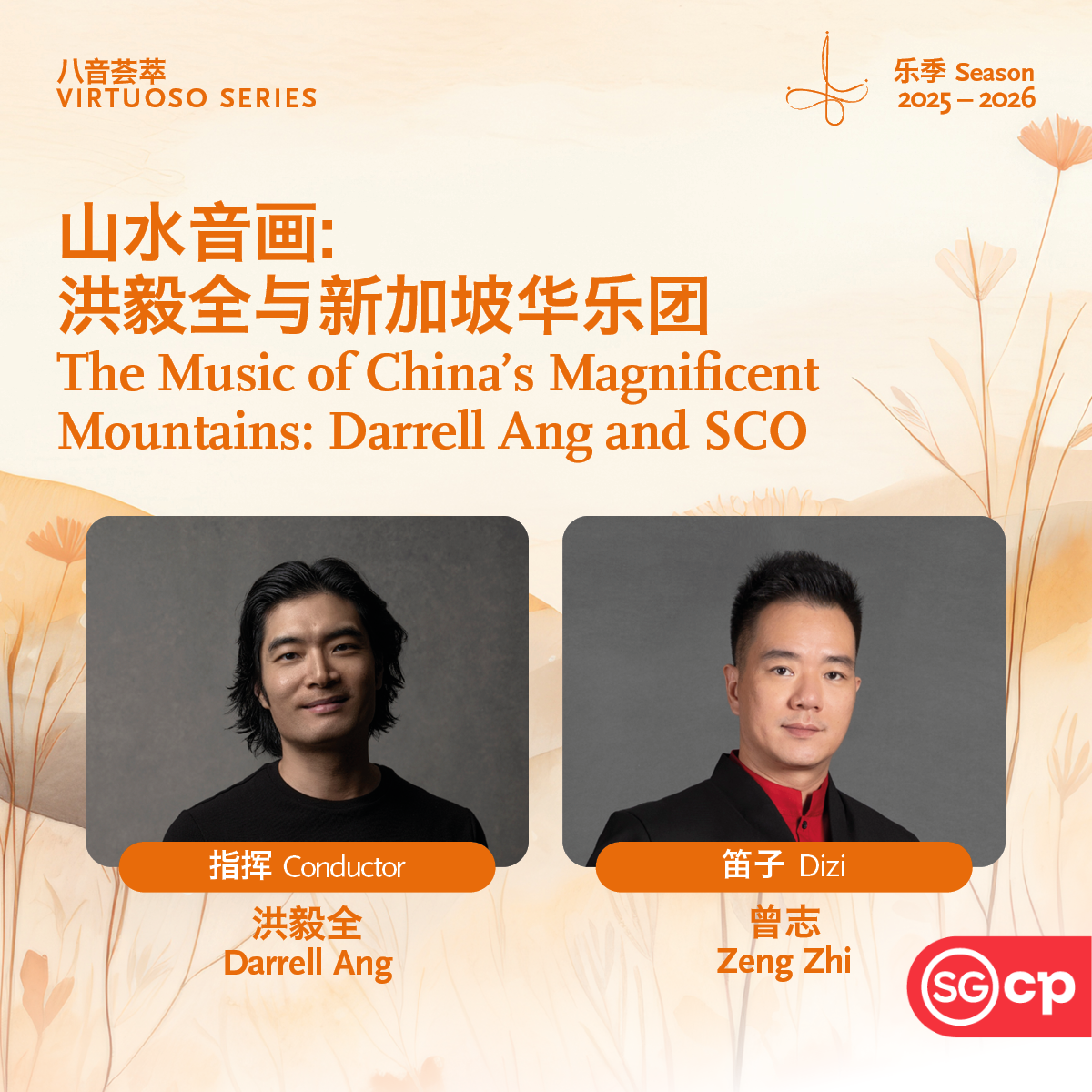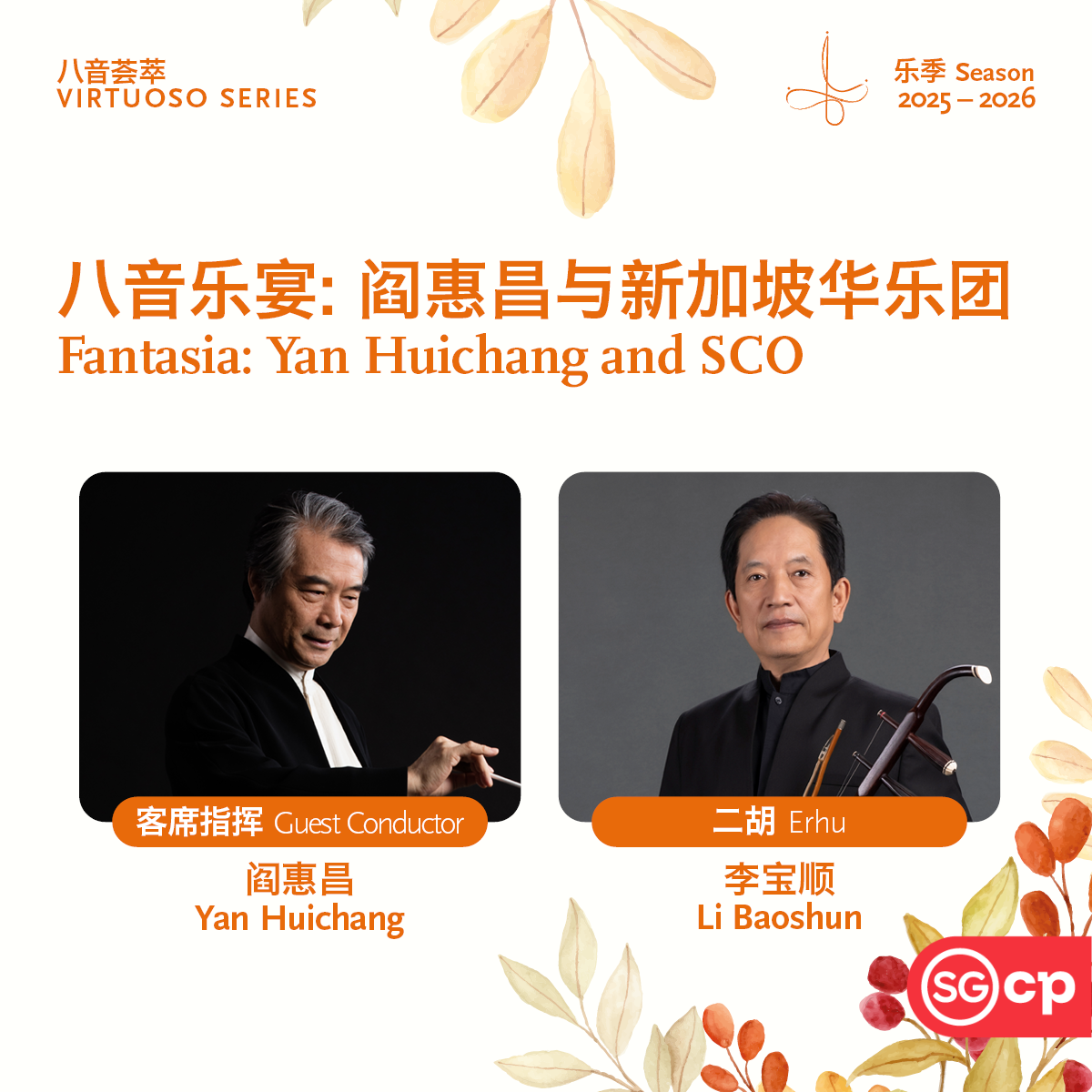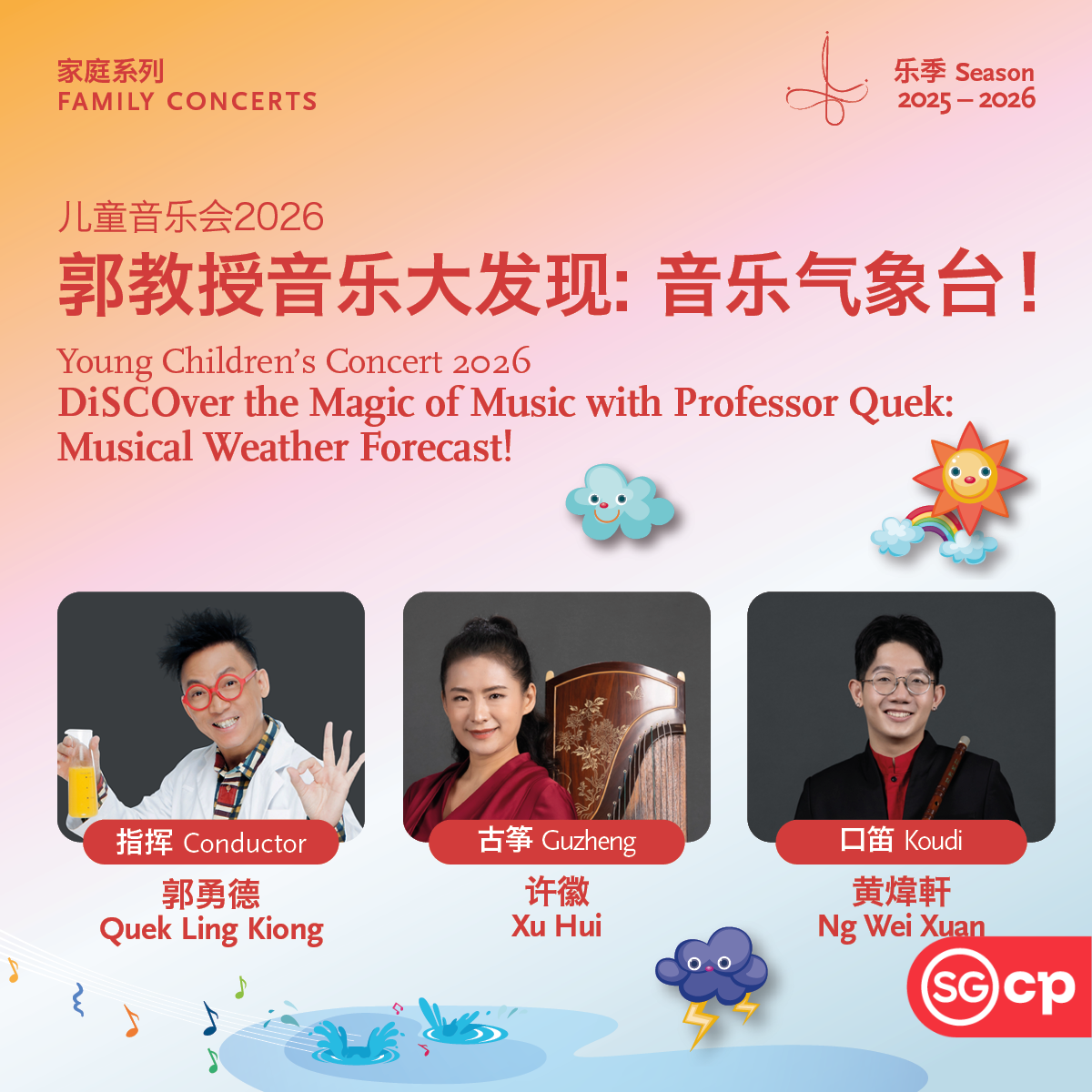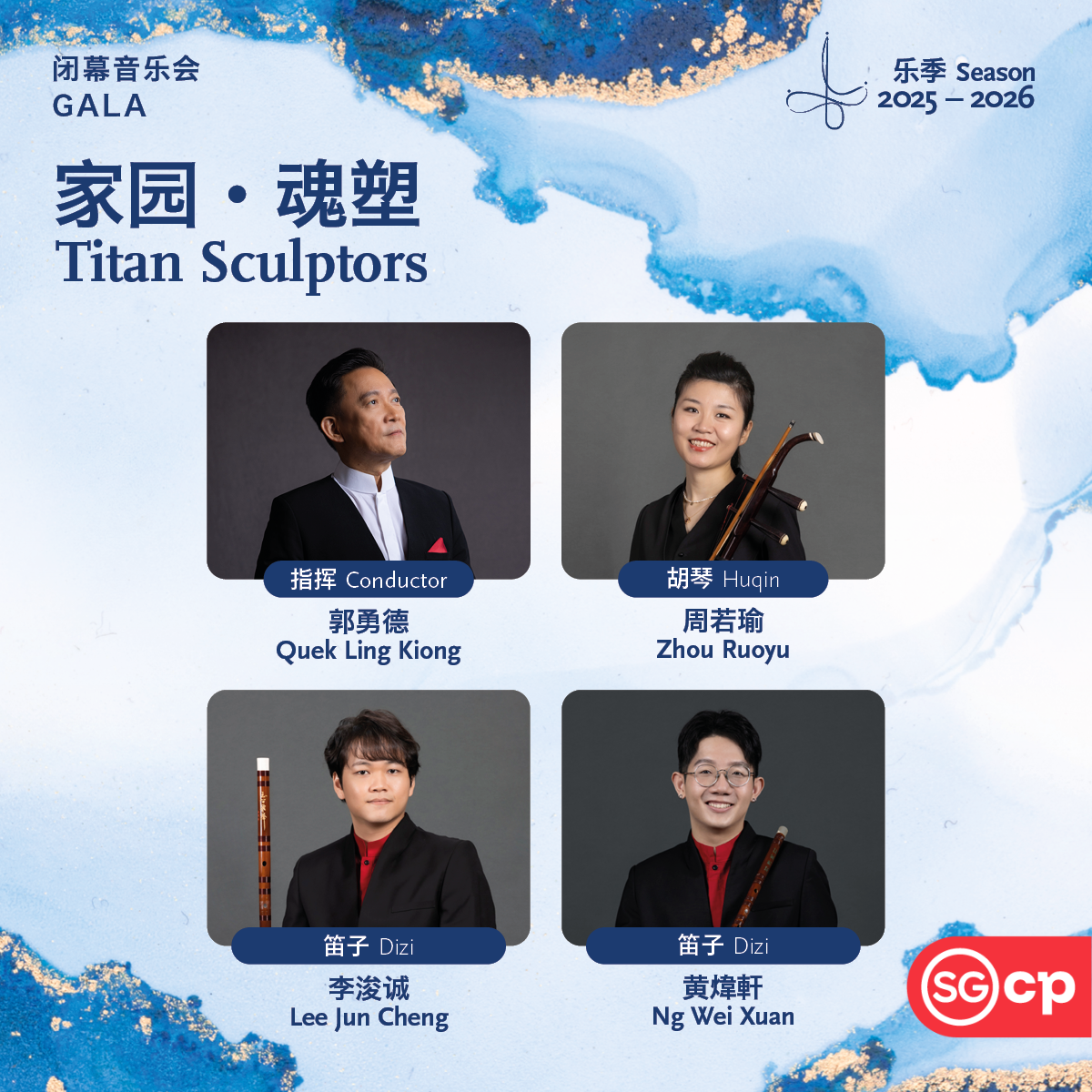As a closing statement to the Singapore Chinese Orchestra’s (SCO) concert season Seamless, this gala concert, presented by the SCO in collaboration with the Singapore Chinese Cultural Centre (SCCC), celebrates the seamless confluence of visual arts and music. Continuing the recently established tradition of ending each season with a tribute concert featuring a Singaporean Cultural Medallion recipient, this year’s performance shines a spotlight on the late Lim Tze Peng, a beloved artist known for his Chinese brush paintings and calligraphy.
Originally conceived as a collaborative performance, the concert was reimagined as a heartfelt musical tribute following Lim’s passing on 3 February 2025 at the age of 104. Speaking with SCO’s Principal Conductor Maestro Quek Ling Kiong about his motivations for programming this concert, he shared that he chose Lim as a collaborative artist due to his profound admiration for Lim’s unwavering work ethic and tireless artistic exploration, even as a self-taught artist who began painting later in life. Lim himself once spoke of being inspired by music, describing how the rhythms would guide his brushstrokes.
The concert is structured into four segments: Affinity of Ink, Legacy of Ink, Impression of Ink, and Symphony of Ink. Each segment explores a unique facet of Lim’s artistic journey.
Affinity of Ink
This opening segment traces the early stages of Lim’s artistic journey, accompanied by two striking oil paintings by Yeh Chi Wei, one of Singapore’s most influential 20th-century artists and a leading member
of the “Ten Men Group”, and whose work played a formative role in shaping Lim’s development. Yeh’s paintings The Dayak Plays the Musical Instrument (1975) and Drummer (1965) reflect strong Southeast Asian influences. These are complemented by the first and third movements of Izpirazione II by Malaysian composer Simon Kong, which similarly draws from Southeast Asian culture. The third movement, Tarap, is particularly evocative of the indigenous music of Borneo, echoing the subjects of Yeh’s works. Young Singaporean composer Sulwyn Lok’s The Cry of Solo River further evokes Southeast Asian sonorities with its use of gamelan textures and its allusion to the Indonesian folk tune Bengawan Solo.
Legacy of Ink
This segment chronicles Lim’s life, pairing photographic projections of key career milestones and personal moments with The Ceilidh by Cultural Medallion recipient Eric Watson. Centered around the theme of gathering, Watson’s work spans a spectrum of emotions from celebratory to sentimental, mirroring the breadth and richness of Lim’s life.
Impression of Ink
Featuring Lim’s own paintings of familiar Singaporean landscapes including scenes of Chinatown, the Singapore River, and trees, this segment links these visual impressions with evocative musical works. Singaporean composer Liong Kit Yeng’s nostalgic Kreta Ayer is paired with Lim’s Chinatown scenes, while the vibrant second movement of Cultural Medallion recipient Law Wai Lun’s A Prosperous River II complements Lim’s animated portrayals of the Singapore River. Lim’s fascination with trees, which became a central subject of his later work and was partly inspired by his grandson’s tree drawings, is highlighted through Zhao Jiping’s In Search of the Roots of the Ancient Pagoda Tree. The hushed opening chords of Zhao’s piece conjure a contemplative, enigmatic atmosphere, mirroring the silent ebb of life and latent vitality that pervades Lim’s arboreal paintings.
Symphony of Ink
The final segment highlights Lim’s work in Chinese calligraphy and presents two specially commissioned works inspired by his artistic philosophies. Symphony of Ink by Young Artist Award recipient Wang Chenwei embodies the spirit of Chinese ink painting and calligraphy through the timbres and textures of the Chinese orchestra. Though inspired by brush techniques and visual composition, the music transcends literal depiction. Instead, these elements are transmuted into a sonic reinterpretation spanning ten sections. The conductor baton in the hands of Quek transforms into a paintbrush for him to paint with musical colours. The concert closes with Spirit of Ink by esteemed Chinese composer Luo Maishuo, inspired by Lim’s innovative hu tu zi (“muddled characters”) technique. Referencing the Qing dynasty calligrapher Zheng Banqiao’s phrase nan de hu tu (“it is a blessing to be muddled”), this technique layers repeated characters in a single space, resulting in a striking abstraction of brushwork and meaning.
By pairing an array of Chinese orchestral works with Lim’s paintings and life story, the SCO offers an artistic tribute to a national treasure once hailed by The Straits Times as “Singapore’s oldest living artist and national treasure.” Through this musical homage, Lim’s spirit, creativity, and legacy continue to resonate vividly and enduringly, like ink flowing across the page.
作为新加坡华乐团《融汇》音乐季的压轴演出,本场由新加坡华乐团与新加坡华族文化中心联合呈献的音乐会将展现视觉艺术与音乐之间的完美融合。延续上乐季以一位本地文化奖章得主作品为闭幕音乐会主题的惯例,今晚的演出聚焦于新加坡艺术界的标志性人物之一 — 书画家林子平。原本计划为一场艺术跨界合作的音乐会,在林子平于今年2月3日以104岁高龄辞世后,本场演出亦转化为一场纪念纪念音乐会,缅怀他的一生、作品与艺术精神。据新加坡华乐团首席指挥郭勇德分享,他之所以选择与林子平合作,源于对林先生孜孜不倦的创作态度与不懈探索精神的深刻敬意。林子平虽为自学成才,且在艺术之路上起步较晚,却不断自我提升,艺术上不停地探索新领域。他曾表示,音乐是其灵感的重要来源,旋律的律动常引导着他的笔触挥洒。本场音乐会共分为四个篇章:“墨缘”、“墨迹”、“墨印”与“墨韵”,而每一章皆以不同视角诠释林子平的艺术生涯。
墨缘
本章描绘林子平步入艺术界的初始阶段,并展出两幅由新加坡20世纪艺术界最具影响力人物之一,亦是“十人画家”代表人物之一的叶之威所绘油画。《达雅克人弹奏乐器》(1975)与《鼓手》(1965)皆展现其浓厚的东南亚文化风格,与马来西亚作曲家江赐良《捕风掠影II:刺的回味》第一与第三乐章相互辉映。第三乐章《香波罗》尤其受到婆罗洲原住民音乐启发,呼应叶之威的绘画题材。此外,新加坡青年作曲家骆思卫的作品《梭罗河之呼唤》同样融入东南亚音乐元素,如加美兰音乐色彩及音乐织体,并引用印尼民谣《美丽的梭罗河》的旋律加以变化,赋予东南亚文化色彩,与叶之威以及林子平的艺术风格相衬。
墨迹
“墨迹”讲述林子平的人生轨迹,透过照片投影呈现其艺术生涯的精彩片段与温馨家庭生活。文化奖章得主埃里克•沃森的作品《同乐会》以聚会为主题,情绪起伏多变,从热烈奔放到温婉细腻,映照出林子平丰富多彩的生命旅程。
墨印
“墨印”展现林子平描绘新加坡景致的代表作,如牛车水、新加坡河与树木景观。新加坡作曲家梁洁莹的《牛车水》搭配林子平笔下的街区画面,引发观众的集体回忆。文化奖章得主罗伟伦的《千舸争游II》则以其蓬勃生命力,映照林子平生动描绘新加坡河的作品。林子平对树木有深厚情感,晚年常以树为题,部分灵感更来自孙儿的童趣画作。中国作曲家赵季平的《古槐寻根》以弦乐奏出一系列的色彩性和声开场,唤起了一种沉思而神秘的氛围,映照出林子平树木画作中那种生命静静流逝却又潜藏生机的气息,也回应他对自然与生命的沉思与探索。
墨韵
终章聚焦林子平的书法艺术,并呈现两首特别委约创作,展现其独特的艺术理念。青年艺术奖得主王辰威的《墨韵》通过华乐团的音色与织体,体现了中国水墨书画的神韵。乐曲虽从笔触技法与视觉造境中汲取灵感,却非以声拟形,而是随十个乐段流转,化墨象为声象。压轴之作《墨魂》由中国著名作曲家罗麦朔创作,灵感源自林子平独创的“糊涂字”技法。该技法透过
反复书写同一字于同一画面,形成层叠交错的笔画与抽象意象,呼应清代书法家郑板桥“难得糊涂”的哲理精神。
通过融合多样风格的华乐作品与林子平的艺术创作及人生故事,新加坡华乐团诚挚地向这位国宝级艺术家致以敬意。他的精神与贡献,将继续在乐音中流转生辉,历久弥新。









